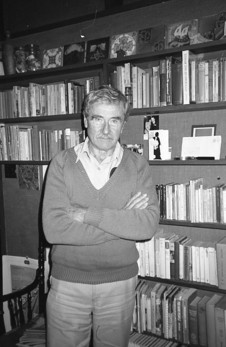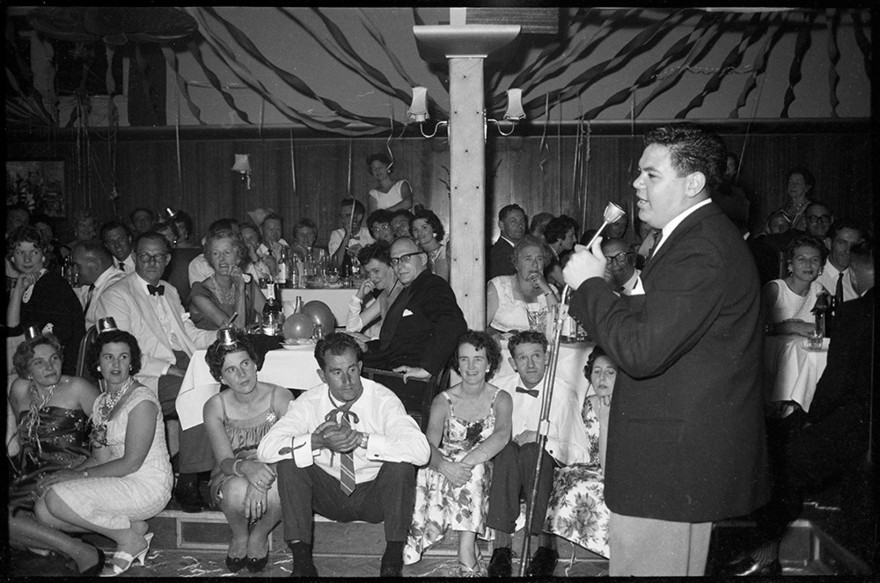Auckland, 1960: There are over 20 night clubs in the city and many of them feature floor shows. Playdate’s after-dark prowler visited some of them on a recent Saturday eve to report on the city’s sophisticated entertainment.
My research into what’s up with nitery floorshows began at the top of the elegant Sapphire Room, that subdued, classy annexe of the Gourmet Restaurant where the business tycoons spend their expense accounts and wealthy American tourists off the Matson liners go when they get homesick. Get the picture: dazzling white linen on the tables, gleaming crystal and silver, David Kennedy originals on the walls, a dance floor about the size of a grand piano and an even smaller stage.

Des Dubbelt, 1987. - Chris Bourke
As I read the menu, Vora Kissin settled in at the piano, giving Gershwin the treatment. Her husky, torchy voice, her edgy keyboard style and her taste that lets only the best of the ballads past, created straight away the atmosphere of a plush New York night club.
On hand among the supporting acts is the English comedian Phil Lovel who, on the night I caught him, was fighting an uphill battle against his material for a scattering of diners who didn’t seem to want to laugh much, anyway.
Working to a tight timetable I was able to get across town and prise myself into the jam-packed Colony just in time to catch the midnight show.
The Colony is what is known in the trade as a plushery – the padded cell look, in satin. The DeMille decor, the low lighting, the appetite-whetting food and the music of the Billy Farnell combo for dancing – all this makes a plain girl look attractive and an attractive one a knockout.
The set-up is made-to-measure for the Colony’s headline act, the Howard Morrison Quartet. Even the hungriest patrons stopped eating while the boys were on and those in the corner alcoves left their tables to get a closer look.

Singer Ricky May at Colony Club, 1961. - Auckland Libraries, Rykenberg Collection, 1269-E164-10
Immaculate in their tuxedos, bathed in a white spotlight and working in close to the ringside tables, the Morrison outfit was something to see – and hear. The songs they sang were old-hat Morrison, but in the opulent bistro atmosphere they all sounded fresh; ‘She’s Mine’ fractured ’em and ‘The Battle of Waikato’ touched off applause that made me glad the building is reinforced concrete.
The place was still simmering as I slipped out of the satin-lined door and over the hill to the Picasso Room. A knotty-pine and scoria-walled cellar close to the Town Hall, the Picasso Room is not, strictly speaking, a night club. It is a coffee shop that keeps night club hours (it was now nearly 1.00am).
Here, the patrons supply the floor show, for the Picasso Room is modelled on London’s Soho espresso bars, where Cliff Richard, Tommy Steele and many another rock’n’roller was discovered. With John Daley making the smooth introductions, any singer or instrumentalist can step up and do his or her piece. After my credentials were squared with the Room’s muscular character, who sends undesirables on their way, I edged between the crowded tables to where Harry Miller, recording company head, was sitting.
“I’ve been here just about every night since this place opened,” he told me, not taking his eyes from a young Māori boy who had just started to sing. “Sooner or later the lad we’ve all been waiting for is going to step out of the crowd, and when he does I want to be here to sign him up.”
But the Māori boy was no Cliff Richard and it was getting late. I moved on down the road to the Arabian, where the late show comes on at 1.30am.
The joint was jumping. Hot jazz licks floated out on to the street.
Here, the joint was jumping. Hot jazz licks floated out on to the street, a bunch of people, some of them waving currency in the doorman’s face, clamoured to be admitted and the dim, smoky light within charged everything with excitement.
The Arabian is the only nitery in town with a chorus line, and the difference the bunch of high-kicking, handsome girls made was unbelievable. Instead of a floor show that was just a series of acts, here the chorus welded everything into a bouncy, non-stop revue.
Paced by Alan Fox, who MC’d the show with just enough wisecracks to keep the customers wanting more, the early-morning hours went like a flash. Levita, with a scantily dressed, sinuous dance, showed what interesting uses there are for exotica-type music. Millie Bradfield sang ‘Autumn Leaves’ with a Fitzgerald-like intensity,Rex (who at 18 is the show’s brilliant dance director) spun around to the strains of ‘Brazil’ with Laura, whose looks and figure are right out of the top drawer, and Pete Barchard, clean-cut as an Ivy League ad in Esquire, delivered ‘A Foggy Day’ in a baritone that put the seal on Top Rank Records’ good sense in signing him as their first local artist.

The Mike Walker trio standing outside the Montmartre and Lautrec coffee lounges on the opening night for Lautrec, across from the current Auckland central library on Lorne Street. From left: Frank Conway, Neville Whitehead, Mike Walker. - Auckland Libraries, Rykenberg Collection, 1269-E161-29
Still the acts kept coming, each one rousing the patons to fresh frenzies of applause. Patti Brittain, a delectable blonde thrush, crooned a couple of torchy numbers, caressing the mike in such a way that every man in the house wished he could swap places with it, the Kay Dancers turned in the most impassioned apache terping seen in these parts and Pat Chapman stepped out of the chorus to sing a couple of unaccompanied numbers (one from Carmen Jones) with a purity and control that silenced even the celebrants at the rear tables.
Famous for its hip atmosphere at this hour, the Arabian attracts many of the town’s performers when their evening’s work is over at the other niteries. I spotted Howard Morrison, Noel McKay and Vora Kissin at nearby tables. John Daley wandered in and was immediately pressed into a guest spot. (For the record, he panicked ’em.)
Later, as I inched my way to the door, I heard a man say, “Look at the time, will you! It’s five o’clock!”
The merriment showed no sign of abating and very few were leaving. The man shook his head in wonder.
“And this,” he said, with awe, “is Auckland!”
--
Consult the Auckland venues map of the 1960s.
First published in Playdate, May 1960. Des Dubbelt edited Playdate until it closed in 1972, and mentored people such as photographer/filmmaker Roger Donaldson and ad man Bob Harvey.